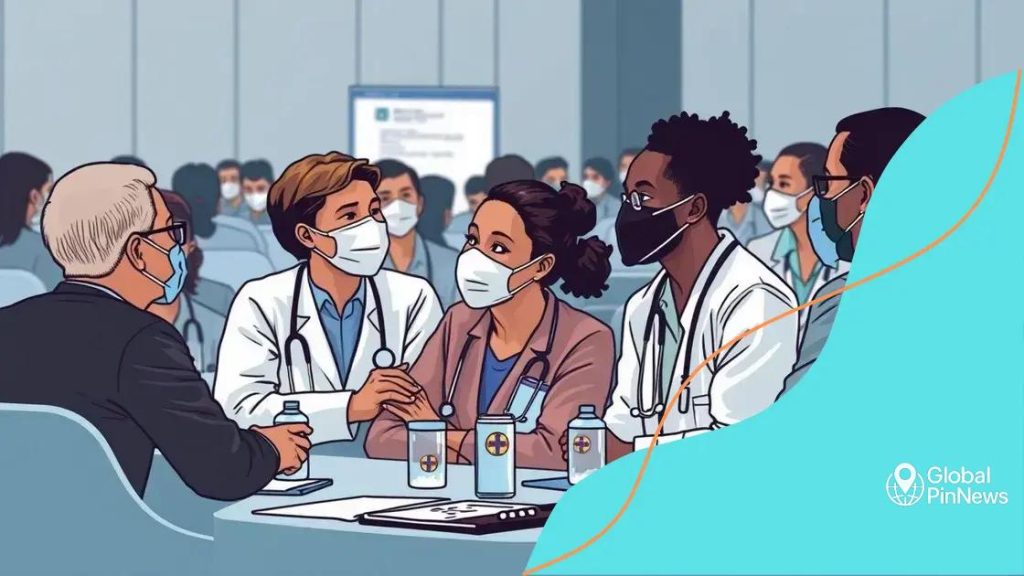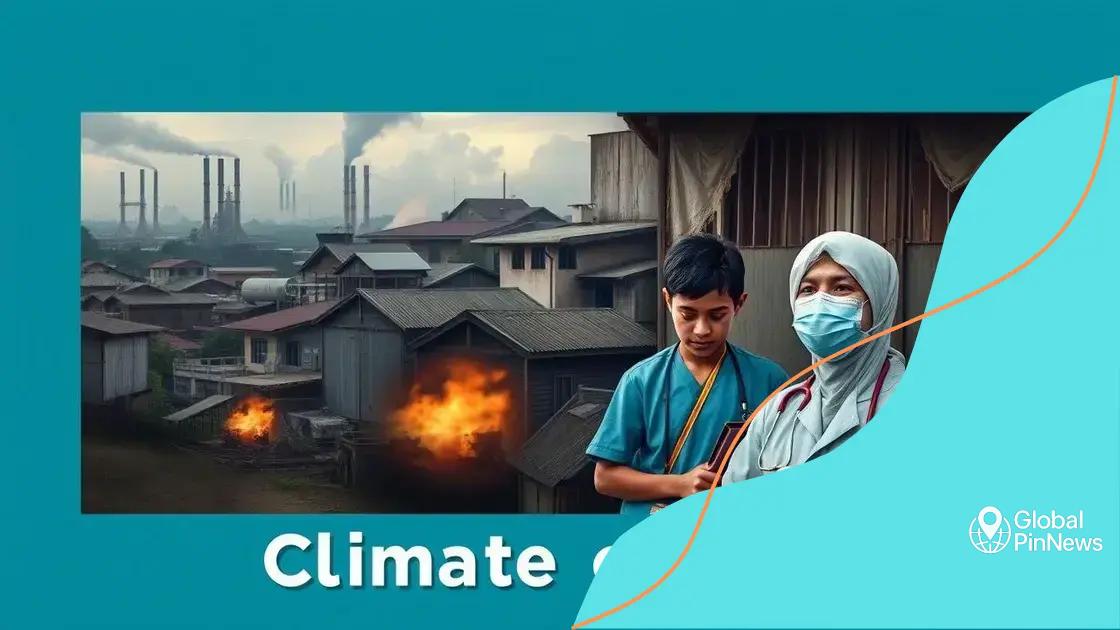Public health updates May 2025: what you need to know

Health policy changes affect communities by increasing access to healthcare, promoting health equity, and engaging local populations in decision-making processes, ultimately leading to improved health outcomes.
Public health updates May 2025 reveal vital information that affects everyone. Have you considered how these changes could impact your community? Let’s explore what you need to know.
Current health crises around the world
Current health crises around the world are pressing issues that affect us all. Understanding these crises can help communities better prepare and respond effectively. One significant concern is the rise of infectious diseases, which can spread rapidly across borders.
Infectious Diseases
In recent years, we have seen outbreaks of diseases like Ebola, Zika, and COVID-19. These outbreaks highlight the importance of global health surveillance and response systems.
- Monitoring disease spread through technology
- Global collaboration among health organizations
- Public education and awareness campaigns
Another critical aspect of current health crises is the impact of mental health. Many people are struggling silently, especially due to the ongoing challenges posed by global events.
Mental health issues such as anxiety and depression have risen significantly. Access to mental health resources is more important than ever. We need to address the stigma associated with mental health to ensure that help is available.
Environmental Factors
Additionally, environmental crises, such as climate change, are contributing to health problems worldwide. Changes in climate can lead to increased respiratory issues, heat-related illnesses, and other health risks.
- Air pollution and its effects on respiratory health
- The link between extreme weather and health outbreaks
- Access to clean water and sanitation
As we navigate these challenges, it is essential to recognize the importance of public health policies. Strong policies can help mitigate the effects of these current health crises and improve community resilience.
Vaccination progress and challenges
Vaccination progress and challenges are critical topics in today’s healthcare discussions. With the ongoing efforts to vaccinate populations globally, it’s vital to recognize both the achievements and the hurdles faced.
Current Vaccination Rates
Globally, vaccination rates have increased significantly over the last few years. Countries are making strides in ensuring that vaccines reach as many people as possible. Vaccination campaigns have been instrumental in combating diseases like measles and polio.
- Increased access to vaccines in low-income countries
- Innovative outreach programs targeting remote communities
- Collaborations between governments and NGOs
Despite these advancements, challenges remain. Misinformation is one of the biggest obstacles to achieving higher vaccination rates. Many people are hesitant about vaccinations due to myths and incorrect information circulating.
Addressing Hesitancy
It is essential to tackle vaccine hesitancy through education and outreach. Public health campaigns aim to inform citizens about the benefits of vaccinations.
- Clear communication from health authorities
- Engaging community leaders to build trust
- Utilizing social media to provide accurate information
Additionally, logistics play a critical role in vaccination efforts. In many regions, ensuring that vaccines are stored properly and distributed efficiently can be a daunting task. Cold chain management is necessary to keep vaccines effective.
Health organizations are working diligently to streamline these processes. Vaccination logistics must adapt to local needs while maintaining global standards. Regular training for healthcare workers ensures they are prepared to overcome logistical challenges.
Impact of climate change on public health

The impact of climate change on public health is a growing concern that affects communities worldwide. As our planet warms, we are seeing various health-related issues emerge. Weather patterns change and extreme events occur, leading to health risks that can no longer be overlooked.
Increased Respiratory Issues
One of the significant effects of climate change is the rise in respiratory problems. Poor air quality from increased pollution can aggravate conditions like asthma and bronchitis. Heat waves further contribute to these issues, prompting people to stay indoors.
- Higher ozone levels exacerbate respiratory illnesses
- Wildfires increase particulate matter in the air
- Higher temperatures can lead to more smog formation
In addition to respiratory conditions, the spread of infectious diseases is another concern. Warmer temperatures can create environments that foster the growth of diseases like malaria and dengue fever. As mosquitoes adapt to new climates, they can thrive in regions previously unsuitable for them.
Extreme Weather Events
Extreme weather events, such as hurricanes and floods, disrupt health services and create additional public health challenges. After such events, access to clean water becomes critical. Contaminated water sources can lead to outbreaks of cholera and other waterborne diseases.
- Displacement of populations due to natural disasters
- Increase in mental health issues following traumatic events
- Challenges in healthcare delivery from damaged infrastructure
As the climate crisis continues, mental health concerns also rise. Individuals facing climate anxiety may experience stress and anxiety linked to uncertain futures. Addressing these mental health needs is essential as we adapt to changing environments.
Public health policies must evolve to tackle these challenges. Integration of climate resilience into health systems is necessary to protect communities and improve overall health outcomes. By understanding the impact of climate change on public health, we can implement effective strategies to mitigate these risks.
Emerging diseases to watch in 2025
Emerging diseases to watch in 2025 are vital for global health awareness. As we navigate changes in our environment and society, new diseases can develop, presenting significant risks to public health.
Understanding Emerging Diseases
Emerging diseases are infections that have newly appeared in a population or have existed but are increasing rapidly. The rise of these diseases often relates to factors like climate change, urbanization, and global travel.
- Travel makes it easier for diseases to spread.
- Urbanization increases contact between humans and animals.
- Climate change alters habitats, allowing diseases to thrive.
As we look towards 2025, experts are particularly focused on several diseases that may rise in prominence. One such disease is Nipah virus, which is transmitted from animals to humans and can lead to severe respiratory illness.
Diseases to Monitor
In addition to Nipah virus, other diseases warrant attention. The resurgence of tuberculosis (TB) poses a challenge due to antibiotic resistance. As treatment becomes more complex, the need for effective public health strategies grows.
- Innovative approaches for TB detection.
- Vaccination programs to reduce TB spread.
- International collaboration to manage outbreaks.
Additionally, zoonotic diseases, such as Zika virus and West Nile virus, can emerge as climates change, creating new breeding grounds for the mosquitoes that spread these infections.
Monitoring these potential threats is crucial. Public health officials must stay vigilant to detect outbreaks early and respond effectively. Education and awareness programs can assist in keeping communities informed about prevention strategies.
Health policy changes affecting communities
Health policy changes affecting communities play a vital role in shaping public health outcomes. These policies can improve access to care, enhance preventive measures, and address health disparities. Understanding these changes is essential for communities to adapt and thrive.
Importance of Health Policy
Health policies provide frameworks for health systems to function effectively. They guide how resources are allocated and define the standards of care. Recent changes have focused on expanding access to healthcare services, especially for underserved populations.
- Increased funding for community health centers.
- Expansion of telehealth services.
- Enhanced mental health support programs.
As policies evolve, they also address critical issues such as health equity. Efforts to eliminate barriers in healthcare access are paramount. Communities benefit most when every individual has equal opportunities for health and wellness.
Community Engagement in Policy Making
Engaging communities in health policy decisions is crucial. Local voices help ensure that policies reflect the actual needs of the population. Initiatives like town hall meetings and surveys can gather valuable feedback from residents.
- Encouraging participation in health forums.
- Presenting data and findings to the community.
- Collaborating with local organizations for outreach.
Additionally, communication around policy changes is vital. Clear messaging can help communities understand new initiatives and programs available to them. For instance, informational campaigns can raise awareness about changes in health insurance coverage or preventive services.
As communities adapt to these policy changes, they must remain informed and proactive. Effective health policies can lead to healthier communities and improved quality of life. The role of local organizations is to help bridge the gap between policy and community implementation.
FAQ – Health Policy Changes Affecting Communities
What are health policy changes?
Health policy changes refer to modifications in laws, regulations, and programs that affect healthcare delivery and access within communities.
Why is community engagement important in health policies?
Community engagement is important because it ensures that local needs and perspectives are considered in the decision-making process, leading to more effective health outcomes.
How do these policies promote health equity?
These policies promote health equity by addressing barriers to care, ensuring all individuals have access to essential health services regardless of their background.
What can I do to stay informed about health policy changes?
You can stay informed by participating in local health forums, reading community bulletins, and following updates from local health departments.
